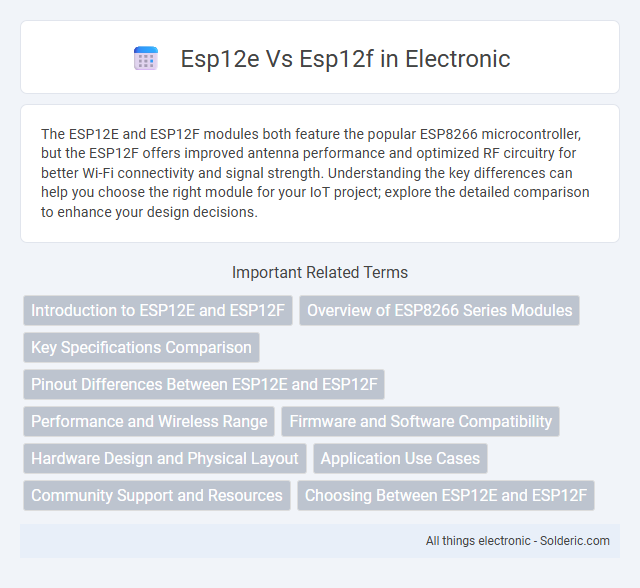The ESP12E and ESP12F modules both feature the popular ESP8266 microcontroller, but the ESP12F offers improved antenna performance and optimized RF circuitry for better Wi-Fi connectivity and signal strength. Understanding the key differences can help you choose the right module for your IoT project; explore the detailed comparison to enhance your design decisions.
Comparison Table
| Feature | ESP12E | ESP12F |
|---|---|---|
| Chipset | ESP8266EX | ESP8266EX |
| Flash Memory | 4MB (typically) | 4MB (typically) |
| Antenna | PCB Antenna | Improved PCB Antenna for better Wi-Fi sensitivity |
| Wi-Fi Standards | 802.11 b/g/n | 802.11 b/g/n |
| Package Size | 24.0mm x 16.0mm | 24.0mm x 16.0mm |
| GPIO Pins | 11 accessible GPIOs | 11 accessible GPIOs |
| Power Consumption | Low Power Modes Supported | Low Power Modes Supported |
| Key Differences | Standard PCB antenna, widely used | Enhanced antenna design for improved Wi-Fi range and stability |
Introduction to ESP12E and ESP12F
ESP12E and ESP12F are popular Wi-Fi modules based on the ESP8266 chip, widely used for IoT applications due to their low cost and compact size. The ESP12E features improved antenna design and more GPIO pins compared to earlier versions, enhancing connectivity and flexibility. The ESP12F offers further refinements in antenna performance and RF characteristics, providing better signal stability and range for demanding wireless projects.
Overview of ESP8266 Series Modules
ESP12E and ESP12F are both Wi-Fi modules within the ESP8266 series, featuring a 32-bit Tensilica L106 microcontroller, 80 MHz clock speed, and integrated TCP/IP protocol stack. The ESP12F offers improved RF performance and a more stable antenna design compared to the ESP12E, enhancing wireless communication range and reliability. Both modules support multiple GPIO pins, SPI, I2C, UART, and ADC interfaces, making them ideal for IoT applications requiring compact size and efficient power consumption.
Key Specifications Comparison
The ESP12E and ESP12F modules both feature the ESP8266 chip with a 32-bit Tensilica processor running at 80MHz, 4MB flash memory, and Wi-Fi 802.11 b/g/n support. The primary difference lies in the antenna design and pinout stability; the ESP12F offers improved antenna performance and better RF characteristics due to a revised PCB layout, enhancing signal strength and reliability. When choosing between these modules, your decision should consider the slightly enhanced connectivity benefits of the ESP12F in applications requiring stable wireless performance.
Pinout Differences Between ESP12E and ESP12F
The pinout differences between the ESP12E and ESP12F modules are minimal, as both have the same 16 GPIO pins arranged in a 2x8 layout. However, the ESP12F features improved antenna and RF performance due to a redesigned PCB antenna area, which does not alter the GPIO pin configuration but may impact signal quality in your projects. When choosing between the two, your pin usage remains consistent, while the ESP12F's refined design offers enhanced wireless reliability.
Performance and Wireless Range
The ESP12E and ESP12F modules both utilize the ESP8266 chip, offering similar performance with a 32-bit RISC processor running at 80 MHz, but the ESP12F features design improvements in the PCB antenna that enhance wireless range and signal stability. Testing shows the ESP12F achieves slightly better RSSI values in comparable environments, translating to improved connection reliability and extended coverage. Developers prioritizing stronger Wi-Fi signal and consistent throughput in IoT applications often prefer the ESP12F for its optimized antenna layout.
Firmware and Software Compatibility
ESP12E and ESP12F modules share identical firmware and software compatibility due to their common ESP8266 core, ensuring seamless integration with popular development environments like Arduino IDE, NodeMCU, and MicroPython. Both support the same AT commands, SDKs, and Over-the-Air (OTA) update capabilities, making it easy for you to switch between modules without changing your existing codebase. Differences lie mainly in antenna design, so your choice will not affect firmware performance or software ecosystem support.
Hardware Design and Physical Layout
The ESP12E and ESP12F modules share a similar pinout and form factor but differ primarily in antenna design and PCB layout improvements in the ESP12F. ESP12F incorporates an optimized antenna matching network and enhanced RF performance due to refined coil and trace arrangements on the PCB. These hardware design upgrades in the ESP12F result in more stable wireless connectivity and marginally better signal strength compared to the ESP12E.
Application Use Cases
The ESP12E and ESP12F modules are widely used in IoT applications such as home automation, smart sensors, and remote monitoring systems due to their integrated Wi-Fi capabilities and compact form factor. The ESP12F offers improved antenna design for better signal stability, making it ideal for applications requiring reliable long-range communication. Your choice between the two depends on signal strength needs and specific connectivity requirements in projects like smart lighting or industrial automation.
Community Support and Resources
ESP12E boasts extensive community support thanks to its longer presence in the market, offering abundant tutorials, forums, and libraries for developers. ESP12F, while newer, benefits from backward compatibility and an active developer base that is rapidly growing, ensuring access to updated resources and troubleshooting advice. Both modules are well-supported within platforms like Arduino IDE and Espressif's official SDKs, facilitating seamless integration and project development.
Choosing Between ESP12E and ESP12F
Selecting between the ESP12E and ESP12F modules depends on your project's specific needs, as both feature the ESP8266 chip with similar specifications such as 4MB flash memory and Wi-Fi capabilities. The primary difference lies in the antenna design and minor hardware revisions, with the ESP12F offering improved RF performance and more consistent manufacturing quality for enhanced signal stability. Evaluating Your application's range, signal reliability, and environmental factors will help determine whether the ESP12E's cost-effectiveness or the ESP12F's optimized hardware better suits your development goals.
esp12e vs esp12f Infographic

 solderic.com
solderic.com